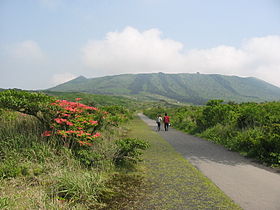- Mount Mihara
-
Mount Mihara 三原山 
Volcanic peak of Mount Mihara.Elevation 764 m (2,507 ft) Location Coordinates 34°43′28″N 139°23′41″E / 34.72444°N 139.39472°ECoordinates: 34°43′28″N 139°23′41″E / 34.72444°N 139.39472°E Geology Type Stratovolcano with summit caldera. Last eruption 1990 Mount Mihara (三原山 Mihara-yama) is an active volcano on the Japanese isle of Izu Ōshima. Although the volcano is predominantly basaltic, major eruptions have occurred at intervals of 100–150 years.[1]
From a vantage point near the top of the cone it was possible to leap straight into the lava flow. As a result, the volcano became a popular venue for suicides. Beginning in the 1920s, several suicides occurred in the volcano every week; more than six hundred people jumped in 1936.[2] Authorities eventually erected a fence around the base of the structure to curb the number of suicides.[citation needed]
Mount Mihara's major eruption in 1986 saw spectacular lava fountains up to 1.6 kilometers high. The eruption had a VEI of 3, and involved a: Central vent eruption, radial fissure eruption, explosive eruption, lava flows and a lava lake eruption. There was also a 16-km high subplinian plume. All of the island's 12,000 inhabitants were evacuated by dozens of vessels consisting of both the military and civilian volunteers.[3]
The most recent eruption was in 1990.[4]
Mihara in popular culture
In the realm of fiction, Mount Mihara was the place where the Japanese government imprisoned Godzilla in the movie Godzilla 1985. Five years later, in the sequel Godzilla vs. Biollante, bombs placed on Mt. Mihara go off and release Godzilla from his fiery tomb. In the novel/motion picture Ring, by Suzuki Koji, it is the location where Shizuko Yamamura, mother of the infamous Sadako Yamamura, took her own life.
Bibliography
- Night Falls Fast: Understanding Suicide by Kay Redfield Jamison, Vintage Books 2000
References
Categories:- Mountains of Tokyo
- Stratovolcanoes
- Tokyo geography stubs
Wikimedia Foundation. 2010.
